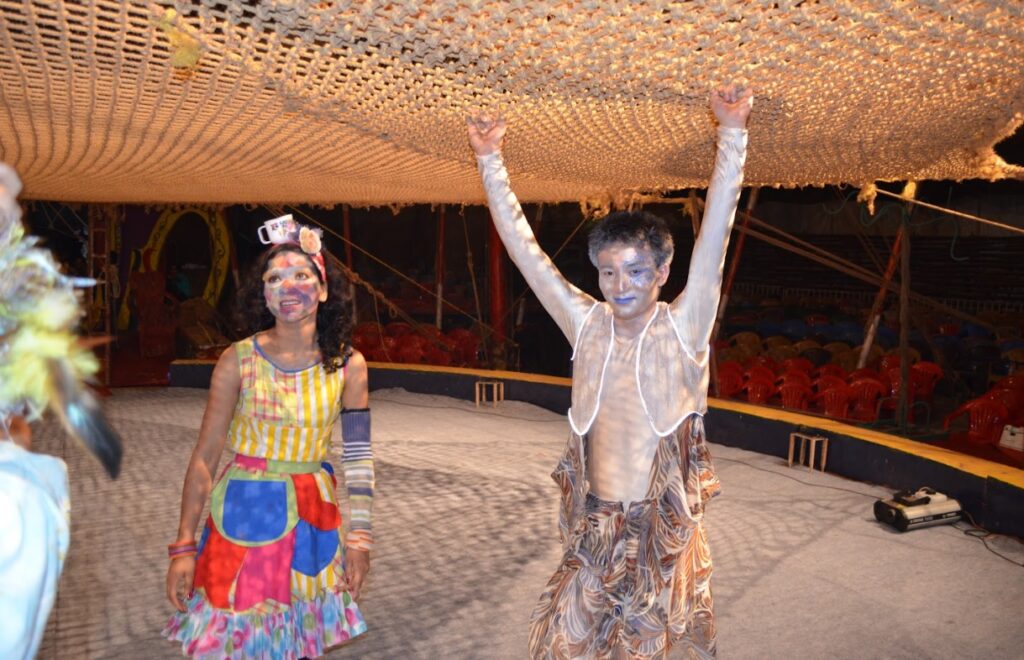Safety net in the form of liberal insurance cover and safety paraphernalia is crucial to a circus artiste.
We live in a world where entertainment has become a crucial element in our society. There are numerous ways to bombard the audience with messages and most of our society tends to recollect television artistes, cinema actors and even theatre personalities. However, circus artistes do not enjoy that kind of celebrity status and popularity among the audience.
In fact, circus artiste and historian Sreedharan Champad rightly points out that the spectators of circus do not even know the names of the most popular circus artistes. It is disheartening to know that artistes who have spent a lifetime being away from their loved ones and put in innumerable hours of training inside the tent right from their childhood without any formal education are not even qualified to be called entertainers in the eyes of the public. Even though it is a common factor that both theatre and circus artistes are performing before the audience, Indian circus artistes do not have fan clubs or well-wishers. On the contrary, the circus artistes are constantly playing with danger, escaping death all through their lives while training and performing their acts. So much that they consider death as a co-star doing a role during their performance.
This constant fear of death that hovers around the circus artiste is disturbing. If a theatre actor or a dancer fumbles or misses a step, even for a moment spectators may not notice it or even look past these flaws. And it may not affect the totality of the performance. However, a momentous misstep on the part of a circus performer results not only in the death of the individual but also adversely affects the performing item altogether.
Discipline is key to practice
In the case of NSD theatre students, they are aware of their roles consciously and subconsciously. They also know that additional practice could help them rectify these slip-ups. But the circus artiste doesn’t have the luxury of additional practice if he or she is injured in the process. Still, they put a smile on their faces and go on with their jobs.
Another factor that inspired the theatre students was the strict discipline they followed during their training period. The general tendency of ‘chalta hai’ attitude (“everything goes”) was not permitted within the circus tents.
During the initial days, Savithri didi excused the theatre students for the errors. On the third day, she said, “Yeh nahin chalega” (“It doesn’t work this way”). “The discipline of circus artistes during training and in the ring is equivalent to that of the training of Indian classical arts and therefore circus is also a valid urban art form,” says art critic M.V. Narayanan. He further adds, “Just like the classical art forms, the circus, too, has a clear-cut motto within the framework of stipulated rules and regulations.” In the training hall of circus artistes, the instructors carve out their bodies in accordance with the requirement of each item as in the case of the classical performing artistes.
Perils inside the tent
The central point in both the arts is the repetition of exercise given to the minutest part of the human body. These repetitions are given to each part of the body by liberating that part from the main body. The result is that each of these trained parts can act in a separate way without the control of other parts of the body.
To achieve this bending and taming, vigorous and systematic training is imparted right from their childhood in both the cases. In the case of Kathakali, the methodical training starts at the tender age of seven or eight. At the age of 13, main parts of the human body are in a state of complete flexibility and plasticity due to the repetitive taming and bending.
This was the method adopted according to the old Gurukula (training given to the disciples in the house of the main teacher) school of training. In the circus, too, ‘catch them young’ was the watchword.
Shri Chakravarthi, a senior artist and trainer of circus artistes from Katpadi in Andhra Pradesh once said, “If the training is started at the age of 10, they have to forgo so many items or such items would have a natural death”.
When a circus company visited Katpadi, he eloped from home and joined the circus company and for the past 38 years he has been an integral part of the circus industry. He has had many big and small falls in the tent and therefore he has bruises all over the body which he shows with a sense of pride.
In Andhra Pradesh when the circus tent was destroyed due to a tornado, he got many cuts and wounds all over his body, the marks of which he still cherishes. In another accident both his legs became motionless, but he slowly recovered and became active in the ring again. This is the life of any circus artiste.
It is a fact that accidents and fear of death is a reality inside circus tents in India. The West emphasizes safety measures adopted in the circus. In India too, these laws are around and gears are available. However, the compliance rate is abysmal in India. Moreover, the harness and safety measures are beyond everyone’s reach and therefore cannot be affordable to all. While making safety paraphernalia is important, equally vital is the availability of liberal financial help in terms of insurance coverage available.
Click here to read more on this series
Photo courtesy: Photo: Priyanka Pathak
Write to us at editor@indiaartreview.com

